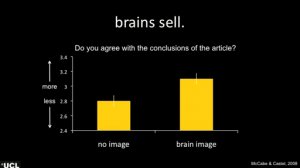
Neuroscience is in the news recently in many guises. It seems that any claim wanting to be taken seriously needs to quote neuroscientific research to back it up.
Why is there a picture of a brain above this article?
Well, in a recent research project several hundred people were asked to read a scientific article. For half the people, the article included a picture of a brain. For the other half it did not. Afterwards everyone was asked how much they agreed with the conclusions of this article. People who read the article agreed more with the conclusions (see the graph below).
 This is a great example of priming in human decision making. Priming means that previous exposure to certain experiences or stimuli unconsciously affect the decisions we make. We make meaning and have feelings based on our recent memories.So we should all hope that clients were reading good things about coaching before their coaching session. Neuroscience has not figured out how priming works yet, it’s like memory but not quite.
This is a great example of priming in human decision making. Priming means that previous exposure to certain experiences or stimuli unconsciously affect the decisions we make. We make meaning and have feelings based on our recent memories.So we should all hope that clients were reading good things about coaching before their coaching session. Neuroscience has not figured out how priming works yet, it’s like memory but not quite.
Neuroscience deals with how the brain works and how this links with our behaviour. As such, it has the promise to link two very separate domains. First, the subjective, soft domain of our subjective experience, that is, our world of values, goals and intentionality. Second, the hard physiology, science based realm of matter – specifically the three pound lump of grey and white matter that resides between our ears. But just because we can correlate parts of the brain and the physiological process there with some of our experiences, this does not mean that they cause our experiences. Our brains are more complicated than we imagine; more complicated than we can ever imagine, after all if a brain could explain itself, it would make a strange and impossible loop, like our eye balls seeing themselves.
There are very few books as yet on neuroscience and coaching – (but look out for many more in the next year), but there are a few practical ideas coaches can take from the research.
One is so called decision fatigue. Decision fatigue means the quality of our decisions tends to deteriorate over time with long periods of decision making. We know when we are tired, our decisions are likely to be worse than when we are rested and relaxed. (Hence never send an angry E mail at the end of the day).
One interesting finding in this area came from a study about the decision making of a Parole Board, in a paper published in 2011. The Parole Board had the very important task of deciding which people should be released early from prison. Their day was divided with two daily food breaks, which meant the day fell into three distinct decision making sessions – before lunch, after lunch but before afternoon break, and after afternoon break. The percentage of favourable rulings (i.e. release the prisoner early), dropped gradually from sixty five percent to nearly zero as each session wore on. After the break, at the beginning of the next session it returned suddenly to sixty five percent.
There is no ‘decision-making site’ in the brain as such, it is a complicated process involving many parts of the brain, although certainly our cerebral cortex, which integrates information, has a lot to do with it. Neuroscience can track changes in the brain when we make decisions during the day, and tell its story in a descriptive language of neurotransmitters and brain states. Our firsthand experience, we know all too well – we get tired and worn out. Our brain (in this case the cortex) has a limited capacity to work on high alert for long periods, we have a limited amount of attention we can give, however much we however much we might wish otherwise.
So if you are unlucky enough to find yourself in trouble with the law and in front of a judge for a court hearing, aim to be the first case of the session – not the last before lunch or tea.
How does this impact coaching? Are the clients you see later in the day, (or just before lunch), the ones you find more difficult to deal with? Could you plan your coaching day better taking this into account?
Do you have coaching clients who have difficulty in making decisions, or complain they make bad ones? Sometimes something as straightforward and obvious as deferring a decision until they feel better can help (maybe after lunch). They may not want to do that, in which case you can explore their reasons with them. However, the evidence is clear – a break will help them. Sometimes the coach needs to reinforce the obvious, if clients go deaf to the voice of common sense.
What about Barack Obama’s suits?
The President of the United States has one of the most stressful jobs in the world, and is presented with hundreds of decisions every day, many of which will have serious consequences. To reduce decision fatigue, one thing he does is to have a small number of suits from which he chooses what to wear each day – no mental processing energy is taken up with the decision on what to wear.
There is a good point here – automate the decisions that are not important and save your mental processing for those that are. And encourage your clients to do the same. The President also likes to have memos that require a decision delivered to him with three checkboxes at the bottom.
These read, ‘Yes’, ‘No’ and ‘Let’s discuss’. I have found this useful for myself and it has also helped some clients.
Next week: Why work life balance asks the wrong questions
Reference: http://www.pnas.org/content/early/2011/03/29/1018033108.abstract
This post is also available in: SpanishPortuguese (Brazil)

